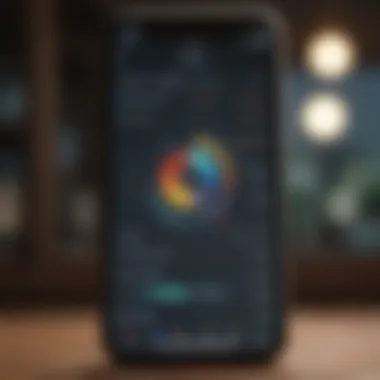Discovering Top Free Budget Apps for Smart Spending


Intro
In recent times, personal finance management has gained significant importance. Individuals seek ways to effectively manage their finances, particularly given the economic uncertainties and shifting financial landscapes. Free budget applications offer a useful solution for this challenge by providing accessible tools to track, plan, and analyze spending habits without incurring additional costs.
Today, many people find themselves grappling with various financial demands. The ability to budget effectively can lead to improved financial security and help achieve long-term goals. Free budgeting apps are particularly valuable to those who may not have the resources to invest in premium financial software. By using these tools, both novices and experienced users can develop a clearer understanding of their financial realities.
This article will dive into various free budgeting applications available on the market. It will evaluate their features, usability, and overall effectiveness. The goal is to guide users in selecting the most suitable app that meets their specific needs. Whether you are new to budgeting or looking to enhance your current process, the insights provided here can assist you in navigating the sometimes-overwhelming landscape of budgeting tools.
Market Overview
Current Market Trends
The financial technology sector has witnessed remarkable growth. More consumers are turning to mobile applications for budgeting purposes. Increased smartphone usage has fueled this trend. As a result, many budgeting apps are designed with user experience in mind, focusing on simplicity and convenience.
Economic Indicators Impacting the Market
Various economic indicators play a role in the popularity and adoption of budgeting apps. For example, rising living costs and uncertain economic conditions prompt individuals to manage their finances more effectively. As people look to take control over their monetary situations, the demand for intuitive budgeting solutions increases.
Global Influences and Major Events
In 2020, the COVID-19 pandemic fundamentally changed financial behaviors. Many individuals found themselves reassessing their financial priorities and looking to create emergency budgets. Global events often shift market trends, underscoring the relevance of budgeting tools as essential resources for managing finances in unpredictable times.
Understanding current trends in the budgeting app market is crucial for selecting the right tool. Effective financial management begins with the right application.
Key Features of Budget Apps
When exploring free budgeting applications, specific features should be considered to ensure effectiveness. Here are critical functionalities:
- Expense Tracking: Users should be able to categorize and monitor expenses easily.
- Budget Planning: Tools to help set and manage budgets create clarity.
- Reporting and Analytics: Insights into spending habits are vital for informed decision-making.
- Syncing with Bank Accounts: Linking bank accounts can streamline transactions and ensure accurate tracking.
The analysis of various options must emphasize these key features while evaluating each app's usability, ensuring selection is tailored to user needs.
Finale
Navigating the world of budgeting apps can be daunting but informative. The right application not only aids in effective financial management but also supports achieving broader financial objectives. This article continues to delve into specific apps available and their unique offerings. By the end, readers will have a clearer picture of which free budgeting app might align best with their financial strategies.
Preamble to Budgeting Apps
Budgeting apps play a vital role in modern personal finance management. They help individuals keep track of their spending, set savings goals, and make informed financial decisions. With increasing economic uncertainty, understanding the importance of budgeting is essential. These apps provide intuitive tools that make financial oversight easier, regardless of one’s financial background.
Understanding the Need for Budgeting
Budgeting is not merely about tracking money; it is about comprehending one’s financial habits and making adjustments where necessary. For many, the absence of a budget leads to overspending, financial stress, and unmet financial goals.
Benefits of budgeting include:
- Awareness of spending patterns
- Ability to save for emergencies
- Control over debt management
- Freedom to allocate funds for investment
Creating a budget assists individuals in identifying unnecessary expenses and prioritizing essential needs. The clarity that a budget provides can guide better purchasing choices and instill discipline in financial behavior.
The Role of Technology in Personal Finance
Technology has transformed how we manage finances. Budgeting apps make it convenient for users to gain insights into their financial status with just a few taps on a smartphone. These applications streamline the budgeting process by offering features that enhance user engagement.
Key aspects of technology in personal finance include:
- Automation of tracking expenses: Many apps can link bank accounts, making it easier to track transactions automatically.
- Data visualization: Most budgeting apps provide graphs and charts to help users understand their spending visually.
- Instant notifications: Alerts regarding spending limits or bill reminders keep users aware of their financial activities.
These technological advancements empower users to manage their finances effectively. The combination of budgeting principles and modern tech creates an environment where users can thrive financially.
Budgeting is more than a beneficial strategy; it is a path to financial resilience in uncertain times.
Criteria for Selecting the Best Budget App
Selecting the right budget app is crucial for managing personal finances effectively. The evaluation of various criteria ensures that users find an app that not only meets their immediate needs but also adapts to their evolving financial situations. By understanding the key elements such as user interface, functionality, bank integration, and security, users can make informed decisions that enhance their budgeting efforts.


User Interface and Usability
User interface plays a fundamental role in the effectiveness of any budget app. A clean and intuitive interface makes it easier for users to navigate through various features. Effective usability can lead to increased engagement and commitment to budgeting practices. Users should look for apps with a straightforward design that minimizes distractions and focuses on essential functionalities.
The importance of usability cannot be overstated. For example, users are more likely to stick with an app that allows for quick entries and instant access to financial data. Many apps offer features like customizable dashboards that display relevant information at a glance. This can significantly enhance the budgeting experience.
To illustrate:
- Easy navigation saves time.
- Customizable interface caters to individual preferences.
- Mobile-friendly designs facilitate budgeting on-the-go.
In essence, the user interface is a powerful determinant of an app's effectiveness in achieving better financial management.
Features and Functionality
When evaluating budget apps, it's crucial to consider the features offered. Each app has a unique set of functionalities that might align with specific financial goals. Common features include expense tracking, financial goal setting, and various reporting options. These elements empower users to understand their spending habits and identify areas for improvement.
Robust functionality can also include features like:
- Expense categorization, which helps in tracking spending by category.
- Bill tracking, allowing users to automate reminders for upcoming payments.
- Insightful analytics, providing visual representations of financial data.
Understanding which features are essential for one’s financial management approach can greatly influence the choice of a budget app, as not all apps cater to the same audience.
Integration with Bank Accounts
Seamless integration with bank accounts is a significant factor to consider. This feature enables automatic transaction imports, thereby reducing manual entry errors and offering a real-time picture of financial health. Without this capability, users may miss critical spending details that could influence their budgeting strategy.
Moreover, users should be aware of the number of financial institutions the app can connect with. Wider integration availability increases convenience and encourages consistent usage. Effective syncing will help users gain insights into their overall financial landscape quickly, thus fostering better decision-making.
Data Security and Privacy
In today's digital age, data security is paramount. Users must ensure that any budget app they consider adopts stringent measures to protect their sensitive financial information. Examine the security features that the app provides, such as encryption and multi-factor authentication.
Additionally, transparency regarding data usage and privacy policies should be a priority in selecting a budgeting app. Users need to know what data is collected and how it is utilized. Protecting personal financial data builds trust and enhances the overall user experience. For users looking to invest their time in budgeting, it is essential to prioritize safety in data handling.
“Security of personal information is as important as the budgeting process itself.”
Overall, a critical evaluation of these criteria will guide users towards a suitable budgeting app that aligns with their financial goals and personal preferences.
Overview of Popular Free Budget Apps
Understanding the landscape of popular budgeting applications is essential for anyone looking to manage their finances effectively. These apps vary in terms of features, user experience, and integration capabilities. Each app has its own set of strengths and weaknesses, impacting how users achieve their financial goals. Budgeting effectively can lead to better savings, improved spending habits, and overall financial well-being. Therefore, analyzing popular apps is not just about features; it is also about how well these tools can facilitate personal finance management.
Mint: Industry Standard
Key Features
Mint stands out due to its comprehensive array of features that cater to both novices and seasoned users alike. One key characteristic is its ability to aggregate financial accounts, providing users a complete overview of their financial situation in one place. This makes tracking expenses, income, and investments simpler. Unique to Mint is its budgeting tool, which recommends spending limits based on user habits. This can guide users effectively towards healthier financial practices.
Pros and Cons
The pros and cons of Mint are significant in understanding its usability. A prominent advantage is its accessibility; it is completely free, making it popular among budget-conscious users. On the other hand, a drawback is the overwhelming amount of data presented. Not all users may find it easy to navigate, potentially complicating the budgeting process. Taking these factors into account helps paint a clearer picture of Mint's overall value.
YNAB (You Need a Budget): A Unique Approach
Core Principles
YNAB operates on unique core principles that emphasize proactive budgeting. This system encourages users to allocate every dollar they earn towards specific expenses or savings goals. This method can significantly alter financial behavior, as it requires mindfulness in spending. By adopting this approach, users can take control over their finances. However, the software does come with a subscription fee after a free trial, which may deter some potential users.
User Experience
The user experience offered by YNAB is another pivotal point. Users appreciate the fact that it prioritizes education alongside budgeting. Many find this educational component invaluable for long-term finance management. However, newcomers may experience a learning curve due to its structured methodology; simplicity takes a backseat to depth.
PocketGuard: Simplifying Budgeting
How it Works


PocketGuard operates under a straightforward principle: track your spending against your set budget. What makes how it works particularly appealing is its “In My Pocket” feature, which calculates how much disposable income you have after accounting for bills, goals, and necessities. This clarity helps users make informed spending decisions. However, some users may find its simplified approach limiting when trying to plan for variable expenses.
Limitations
The limitations of PocketGuard stem from its lack of customization options. While it works well for users with stable incomes and expenses, those with more fluid financial situations may find it less effective. Understanding these constraints is crucial for evaluating whether it aligns with one's budgeting needs.
EveryDollar: A Practical Tool
Setup Process
EveryDollar simplifies the setup process. Users can quickly create their first budget in a straightforward manner. The design allows for easy input of expenses, categories, and income sources. This simplicity is beneficial for individuals looking to dive into budgeting without unnecessary complications. However, this initial ease may not carry through if users desire more advanced features later.
Budgeting Methodology
EveryDollar adopts a budgeting methodology that follows a zero-based approach. Every dollar is assigned a purpose, significantly enhancing financial awareness. Yet, the app lacks automatic syncing with bank accounts in its free version, which could be a downside for people looking for automated tracking.
GoodBudget: Envelope Budgeting Digitized
Functionality Overview
GoodBudget reinvents the functionality overview of traditional envelope budgeting. Users can allocate funds to digital envelopes for various categories. This feature is beneficial for visual learners who prefer a tangible method of tracking spending. Still, the lack of bank synchronization can hinder real-time tracking for some users.
Storage and Usability
The storage and usability aspect of GoodBudget is designed for simplicity, allowing users to manage envelopes with ease. However, its reliance on manual entry may be a drawback for users expecting automated features offered by other apps.
Comparative Analysis of Features
In the realm of personal finance management, a comparative analysis of features offered by different budgeting apps is crucial. Users often have diverse needs, and understanding these variations can greatly enhance one's ability to manage financial resources effectively. This analysis highlights specific functions, usability aspects, and customization options available in various applications. Consequently, each user can identify the app that aligns most closely with their fiscal objectives and personal preferences.
Functionality vs.
Usability
When comparing budgeting apps, functionality and usability are two of the most significant attributes to consider. Functionality refers to the features and tools that the app provides. This may include options for tracking expenses, creating budgets, or visualizing spending patterns. The more capabilities an app has, the more it can cater to diverse financial situations.
Usability, on the other hand, encompasses the overall user experience. An app may possess extensive functionality, but if it is overly complicated or confusing to navigate, users may abandon it for something simpler.
Users should find an equilibrium between functionality and usability. Ideally, a budgeting app should offer robust features while maintaining an intuitive interface. Many apps strike this balance, but it is essential for users to test apps to see which one feels right for their specific needs.
Customization Capabilities
Customization capabilities significantly enhance a user's experience with budgeting applications. Each individual's financial situation is unique, and therefore, a one-size-fits-all solution rarely works effectively. Users benefit from apps that allow them to tailor settings according to their specific requirements.
Features such as customizable categories for expenses, adjustable budget limits, and the ability to set personal financial goals can make a considerable difference.
Moreover, the ability to personalize notifications and alerts can keep users engaged and informed about their spending habits. While some apps offer limited customization, others, like YNAB, provide extensive options, allowing users to create a budgeting experience that resonates with their financial philosophy.
User Experiences and Testimonials
User experiences and testimonials play a crucial role in understanding the effectiveness of budgeting apps. They provide real-life insights that go beyond marketing claims. Evaluating user feedback helps potential users discern which features are truly beneficial and what flaws might exist.
Additionally, testimonials can illustrate the range of experiences different consumers have with budgeting apps. They highlight differing needs and expectations and show how diverse users adapt these tools to their lifestyles.
By examining case studies and feedback, we can offer a more comprehensive view of budgeting apps, ensuring users find the best fit for their financial needs.
Case Studies: Long-term Users
Long-term users of budgeting apps often possess significant insights into their capabilities. Their perspectives can illuminate both advantages and disadvantages not visible to short-term users. For example, a user of YNAB (You Need a Budget) may share how the app helped them transition from a reactive spending approach to proactive financial management.
One such user emphasizes the importance of habit formation. Over time, the app prompted them to adjust their budgeting strategies, which improved their discipline. They found that regular check-ins with the app increased their awareness of spending habits. On the other hand, another long-term user of Mint may highlight frustrations with frequent updates that altered features they relied on.
These insights, drawn from in-depth experiences, paint a clearer picture of how effective each app can be in achieving financial goals. They also expose issues potential users may wish to consider before committing to a particular service.
Feedback from New Users


New users offer a different yet equally valuable perspective. Their experiences can reveal the initial hurdles and learning curves associated with adopting a new budgeting app. For example, first-time users of PocketGuard may appreciate its simplicity but struggle with setting up categories that reflect their unique financial situations.
Similarly, new users can express excitement over features they find most helpful, such as the seamless bank integration provided by GoodBudget. They often spotlight the initial friendliness of the user interface, which is critical for attracting users who may feel intimidated by budgeting technology.
Feedback from this group can also indicate trends in user preferences, as newer users can reveal what features they initially sought. For instance, many prioritize ease of use and seek apps that offer a intuitive setup process. Understanding how new users perceive these applications helps shape future developments and improvements in functionality, ultimately benefiting both new and existing users.
Connecting Budgeting Apps to Investment Goals
Connecting budgeting apps to investment goals is a critical aspect of modern financial planning. As personal finance continues to evolve, individuals increasingly seek ways to align their spending habits with their long-term financial aspirations. These apps serve as crucial tools for monitoring daily expenses while simultaneously tracking and supporting investments.
Integrating budgeting practices with investment objectives provides several benefits. First, it encourages discipline in spending. By clearly outlining expenses against income and available investments, individuals can make informed financial decisions. Without a clear understanding of cash flow, it is challenging to allocate funds towards investments effectively.
Secondly, budgeting apps help define specific financial goals. Users often find they need clarity when setting short-term and long-term objectives related to their investments. The right budgeting app can facilitate this process by enabling users to visualize their progress towards meeting those goals. The combination of meticulous spending tracking with investment monitoring can yield a holistic view of one's financial health.
Finally, these apps often come with features to track performance. This allows users to assess whether they are on the right track to meet their financial targets. It instills a sense of accountability as the data gathered equips users to adjust their habits proactively.
Setting Financial Goals
Setting financial goals is foundational in personal finance. Users must identify objectives that are specific, measurable, achievable, relevant, and time-bound. First, it is essential to differentiate between short-term goals, like saving for a vacation, and long-term goals, such as retirement plans.
A budgeting app can assist in establishing clear boundaries for each goal. For example, users can create separate categories in the app to allocate funds designated for specific investments. This breakdown provides transparency and encourages smoother progress tracking.
Moreover, using distinct financial categories, users can prioritize which goals take precedence based on their timelines and personal circumstances. This not only streamlines budgeting efforts but also makes the investment process more suited to individual needs.
Tracking Progress Through Budget Apps
Tracking progress through budgeting apps is paramount as it creates a direct correlation between goals and daily actions. Regularly updated data helps users identify areas of improvement and recognize financial patterns. By monitoring spending habits, individuals gain insights into where they can cut back to increase investment contributions.
Often, budgeting apps include visualization tools that enhance understanding through graphs and charts. These features can display the percentage of income spent versus saved and highlight growth towards investment goals. Such visual feedback can be motivating, making financial accomplishments more tangible.
Furthermore, many budgeting applications allow for real-time updates, ensuring users are aware of their current financial standing. This immediacy can be crucial for timely decision-making, allowing for adjustments to be made before potential pitfalls occur.
Future Trends in Budgeting Technology
Understanding the future trends in budgeting technology is crucial for anyone attempting to navigate the complexities of personal finance. As technology evolves, so do the tools available to assist users in managing their money. Not only is it important for current users to stay informed about these trends, but newcomers should also be aware to make educated decisions about which budgeting apps to adopt. The landscape of budgeting apps is changing rapidly, and staying ahead of the curve can lead to better financial management and smarter investment decisions.
Emerging Technologies
Emerging technologies offer promising solutions that can transform the way budgeting apps operate. One notable trend is the incorporation of artificial intelligence (AI) into financial applications. This technology can analyze spending patterns and suggest personalized budgeting strategies. For instance, an app powered by AI might notify users about unusual spending behavior or recommend adjustments based on financial goals.
Another advancement is the use of blockchain technology, which enhances the security of financial transactions. Users can expect increased transparency and reduced risk of fraud. This can lead to greater trust in budget apps, encouraging more individuals to engage with their financial data.
Moreover, open banking is paving the way for apps to access users' bank information securely. This allows for more integrated solutions, where users can see their entire financial landscape in one place. By leveraging these technologies, budgeting apps will provide users with richer data and more robust tools to manage their finances effectively.
Potential Market Changes
The financial technology (fintech) sector is seeing major shifts that will undoubtedly influence budgeting apps. As consumer needs evolve, there's a growing demand for apps that not only help with budgeting but also integrate investment features. Users are looking for comprehensive platforms that merge budgeting, saving, and investing in a seamless manner.
Additionally, as millennials and Generation Z enter the financial landscape, their preferences will shape market changes. These groups prioritize user experience and seek solutions that simplify complex financial concepts. Budgeting apps in the future will likely focus on creating intuitive interfaces that resonate more with younger audiences.
Furthermore, regulatory changes could impact how budgeting apps operate. Compliance with new financial regulations might lead to improved transparency and data handling practices, making budgeting tools safer for users.
Ending
Final Thoughts on Choosing a Budget App
Selecting the right budget app is a crucial decision for anyone aiming to gain better control over their finances. With various options available, understanding the unique features and functionalities of each app can lead to more informed choices. The article presented a variety of free budget apps, each with strengths and limitations, catering to different personal finance needs.
Every app has its design and interface. A user-friendly experience is essential, ensuring you can navigate the app without frustration. Features such as syncing with bank accounts or custom budgeting categories can significantly enhance usability. Assessing your personal financial goals will determine which app aligns best with your needs. This process can also involve considering data security, as personal finance is sensitive.
In summary, choose an app that not only provides the necessary tools for budgeting but also feels comfortable to use. Identifying personal preferences is key to making a successful choice.
Encouragement to Begin Budgeting
Starting your budgeting journey can feel overwhelming, yet it is one of the most rewarding financial practices. Budgeting allows you to gain insights into your spending patterns and identify areas to save. It's an opportunity to set realistic financial goals and witness your progress over time.
Commencing with a budget app simplifies the process. Many of these free apps offer helpful tutorials and support that guide you through setup and management. With a clear picture of your finances, you can make educated decisions about savings and expenditures.
Take the first step towards financial discipline today. The benefits of budgeting far outweigh the initial hurdles. Remember, every small change contributes to a larger impact on your financial health.
Budgeting is not just about restricting expenses; it is about understanding where your money goes and making it work for you.



